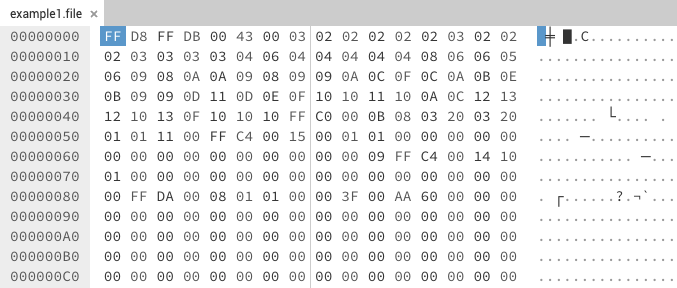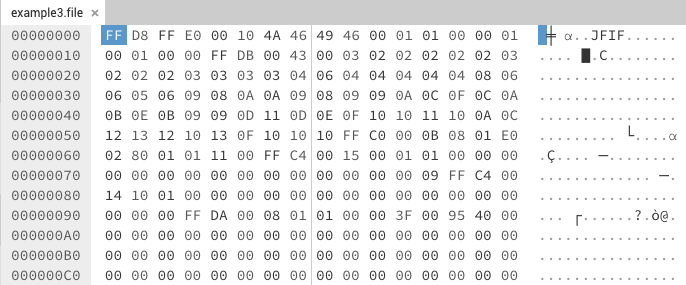Looking for patterns
Last updated on 2025-11-02 | Edit this page
Estimated time: 5 minutes
Overview
Questions
- Do my samples have the same “magic” numbers?
- What version do these files represent?
- Do I need more samples to draw conclusions?
- Do I have access to a format specification?
Objectives
- Recognize patterns in sample files.
- Have more confidence in deciding which values to use in a signature.
- Read a format specification and draw conclusions.
Exploring file types
With a hex editor you can now explore all file types regardless of
format. This comes in handy when exploring files which don’t seem to be
identify with existing tools. You can quickly open the file to view the
hex byte sequences and start to understand the format of the file.
Opening a single file in a hex editor can be illuminating or
seem like you just entered the Matrix.

In this example we don’t really know much about the file as the extension is not known and there is no human readable text to help. So by itself this file is hard to identify.
Searching for the bytes
We can take some of the byte sequences and use search engines to try and find references to the sequences as one solution or if you have additional files with the same extension you can use them to compare.
Comparing samples

With a second file we can start to see differences and similarities
between them. The most noticeable is the first two bytes “FF D8”. This
second example also has a bit of human readable text which can also help
in identification. The more samples you have the more confident you can
be in choosing a byte sequence to use for a signature.
You may
find patterns that work with some of your samples but not with others,
Choosing a byte sequence too short may clash with other file formats,
but sequences too long may be too strict. Your sample files may
represent files saved with different versions of the same software which
can alter their structure. This can be helpful if you want to identify a
file down to the version of the software which created it.
Creating samples
Being able to create sample files using original software or finding samples specific to a certain version of software is a big help in determining identification. Look for tutorials, sample files on installer disks, or create your own using trial versions of the software.
Referencing the specification
Having a file format specification can be the most helpful in understanding a file format, but isn’t always available. In the case of the example files above, we can see in the T.81 specification for compressed images, the “FF D8” sequence is used as the start of image bytes for a JPEG file. The specification also gives us what should be at the end of the file as well, “FF D9”.
| 0xFFD8 | SOI | Start of image |
| 0xFFD9 | EOI | End of image |
| 0xFFDA | SOS | Start of scan |
| 0xFFDB | DQT | Define quantization table(s) |
| 0xFFDC | DNL | Define number of lines |
| 0xFFDD | DRI | Define restart interval |
| 0xFFDE | DHP | Define hierarchical progression |
| 0xFFDF | EXP | Expand reference component(s) |
| 0xFFE0 through 0xFFEF | APP | Reserved for application segments |
| 0xFFF0 through 0xFFFD | JPG | Reserved for JPEG extensions |
| 0xFFFE | COM | Comment |
0xFFD9
As you progress further into this research, you will want to find sample files. There may be some samples known to you. Finding samples from heterogeneous sources can help to remove biases in signatures and ensure that your work is globally applicable and not just local.
Resources for finding Sample files
Tyler has developed a resource for helping to find sample files for format identification research.
- The more samples from different versions of the format can ensure better identification.
- Not all formats have available specifications
- The more variations in samples, patterns emerge.
